Introduction
AI chatbots have become essential tools for enhancing user interaction, offering efficient and personalized experiences in various industries. There are two primary types of AI chatbots: rule-based systems and machine learning-driven ones. Rule-based chatbots rely on established rules and triggers to provide precise responses, while machine learning chatbots continuously learn and evolve, adapting to the nuances of human language.
It’s crucial to understand these types when planning a chatbot strategy, as they have different strengths for different use cases. Implementing AI chatbots can lead to impressive returns on investment, automating up to 70% of customer requests and improving operational efficiency. As AI chatbots continue to evolve, they have the potential to act as sophisticated assistants, driving long-term product strategies and operational goals.
Understanding AI Chatbot Types
AI, indispensable tools for improving user engagement, are available in two main types: rule-based systems and those powered by machine learning. Rule-based automated conversational systems are like meticulous librarians, following a strict categorization system to respond to queries. They rely on a series of established rules and triggers, which when activated, produce the appropriate responses. This approach is precise, but its rigidity can be a limitation for complex or nuanced interactions.
On the other side of the spectrum, we have machine learning-based chatbots. These are the marvels of the automated conversational system realm, constantly acquiring knowledge and progressing. They utilize robust AI algorithms to digest vast amounts of data, learning and refining their conversation skills over time. This enables a more natural interaction with users, as the AI assistant can comprehend and adjust to the intricacies of human language.
The difference between these two categories is important when devising your conversational agent approach. For example, a healthcare provider might use a rule-based automated system for scheduling appointments, where clear-cut rules are sufficient. But they might switch to a machine learning AI for patient interactions, where understanding context and history can significantly enhance care quality.
Real-world applications showcase the capabilities of AI virtual assistants. Consider the NHS’s digital service team’s adoption process for new technologies. They start with a thorough assessment to ensure security and compliance, similar to how a machine learning chatbot would evaluate conversations to provide compliant and relevant responses.
Implementing AI conversational agents can also be a strategic move for businesses, offering an impressive return on investment (ROI). Statistics show that AI can automate up to 70% of customer requests, a significant efficiency boost. Retail companies, for example, have seen over 63% of them utilizing AI to improve customer service.
As AI virtual assistants advance, they are increasingly capable of acting as sophisticated ‘co-pilots’ in various industries, providing invaluable assistance that aligns with long-term product strategies and operational goals. The journey of integrating AI into your operations might start with identifying the right type of chatbot for your needs, but it extends far into the strategic planning and continuous improvement of the service.
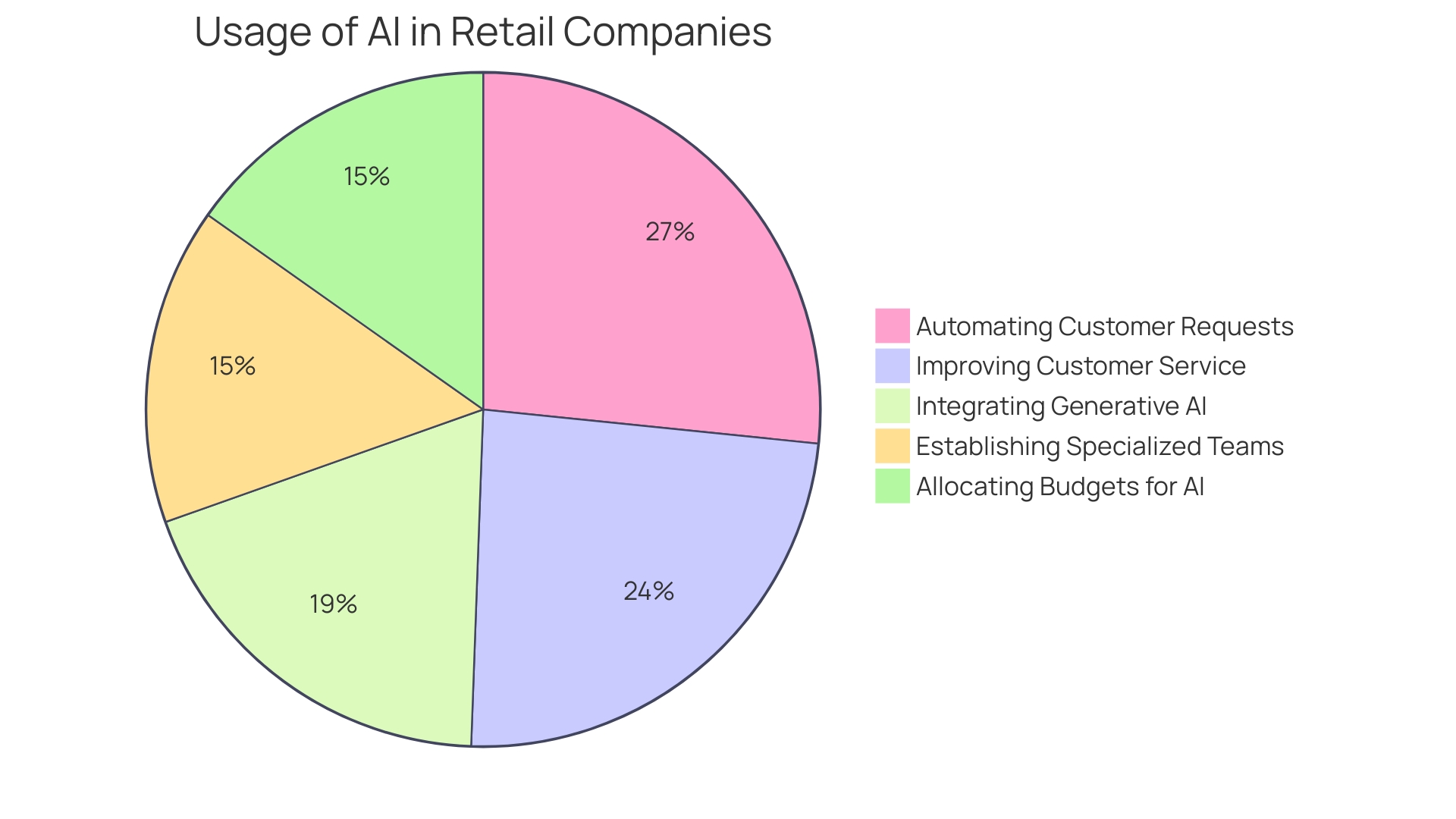
Key Components of AI Chatbots
Artificial intelligence conversational agents are created with a sophisticated combination of elements that together allow them to facilitate an engaging interactive experience. At the core of these systems lies the Natural Language Processing (NLP) module, a critical feature that equips chatbots with the ability to comprehend and process human language as it is naturally spoken or typed. This allows for a nuanced understanding of user queries and statements. Complementing the NLP is the Dialogue Management module, which plays a pivotal role in guiding the conversation flow, ensuring that responses are contextually relevant and coherent with the ongoing interaction.
In addition to these, conversational agents are anchored by an extensive Knowledge Base, a repository of information that the virtual assistant accesses to deliver accurate and informative responses. This database is continually updated and expanded to encompass a wide range of topics and data. The user interface, often the most visible component of a conversational AI, offers a user-friendly platform for engagement, allowing for seamless communication between the user and the virtual assistant.
The incorporation of these elements is demonstrated in the healthcare industry, where AI virtual assistants are increasingly used to facilitate inquiries for new digital technologies. For instance, in the NHS, the Digital Service Team employs a rigorous assessment process, aided by an AI chatbot, to evaluate whether requested technologies are secure, appropriate, and compliant. This use case highlights the practicality of AI-powered virtual assistants in managing complex workflows and improving operational efficiency.
Recent progress in AI, like the release of Chat GPT-4 by OpenAI, has continued to expand the limits of what conversational agents can accomplish. With an expanded input capacity and a growing developer ecosystem, these systems are now capable of handling intricate tasks that were previously the domain of humans. The advent of such technologies demands careful consideration of ethical implications, including the privacy of individuals and transparency in AI engagements, ensuring individuals are aware that they are communicating with a machine.
As AI virtual assistants continue to evolve, they hold the potential to not only enhance user interaction but also to significantly impact the operational efficiency and decision-making processes within various industries.
Step 1: Identify the Type of Chatbot
Selecting the optimal AI conversational agent for your company relies on comprehending your main objectives. Whether it’s slashing call center volumes by half or curbing shopping cart abandonment by 10%, these targets can translate into significant financial gains. For instance, in the energy sector, companies like Enefit have leveraged chatbots to navigate vast document bases, cutting down the time employees spend searching for information from an average of 18 minutes to a mere instant response. Similarly, in healthcare, digital request forms streamline technology adoption, ensuring secure, compliant solutions are in place. With the appropriate tools, an AI conversational agent can be a strategic asset, aligning with long-term product strategies and offering a measurable return on investment, especially when integrated with technologies like blockchain for secure, multilingual interactions, as observed with tech innovators like Exfluency. When devising your conversational AI strategy, contemplate these innovative approaches and evaluate your ROI to guarantee your virtual assistant becomes as valuable as any other corporate asset.
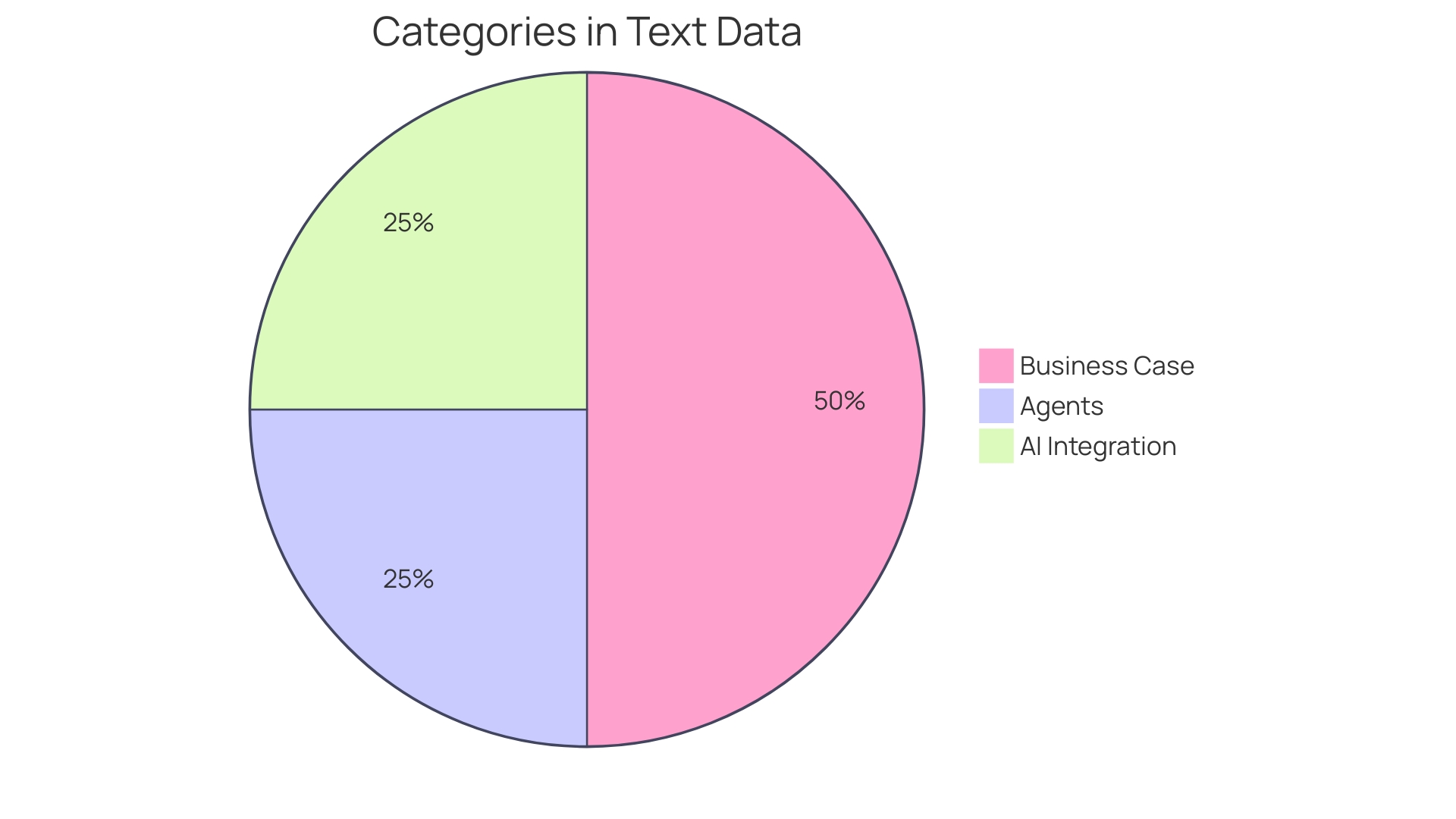
Step 2: Set Goals and Objectives
When venturing into the realm of intelligent virtual assistant development, identifying the specific functions and responsibilities your AI assistant will undertake is crucial. It’s not just about programming a conversational AI; it’s about sculpting a digital assistant that integrates seamlessly with your business model and enhances user interaction. For instance, in the case of Enefit, a large-scale energy company operating in various markets, the implementation of an automated messaging system significantly enhanced the swiftness and effectiveness of internal document retrieval – reducing the average search time from 18 minutes to just seconds.
To harness similar efficiency, begin with a broad vision and then zoom in on the particularities. Which tasks should it handle? Is it for customer service, internal communications, or perhaps a mix of both? By setting clear goals, such as reducing response times or providing round-the-clock support, your automated messaging system becomes a strategic asset. Remember, the key is in the details – it’s about creating a tool tailored to your unique operational needs.
Utilize quantifiable results to monitor the performance of the automated conversational agent. Are customers finding the answers they need? How has the automated messaging system affected the workload of your customer service team? These metrics serve as a beacon, guiding the ongoing improvement of your conversational AI system. Obtain ideas from the advancements in AI conversation software technology, wherein new models recall prior engagements, thus providing customized experiences to individuals – a characteristic that is not merely an extravagant addition but a vital component in customer contentment.
Incorporating these objectives and measures into the development process means that, upon deployment, your AI assistant will not just be another piece of software, but a dynamic, evolving member of your team dedicated to enhancing the individual’s experience. This strategic method for developing conversational agents guarantees that your investment yields returns in improved engagement and operational effectiveness.
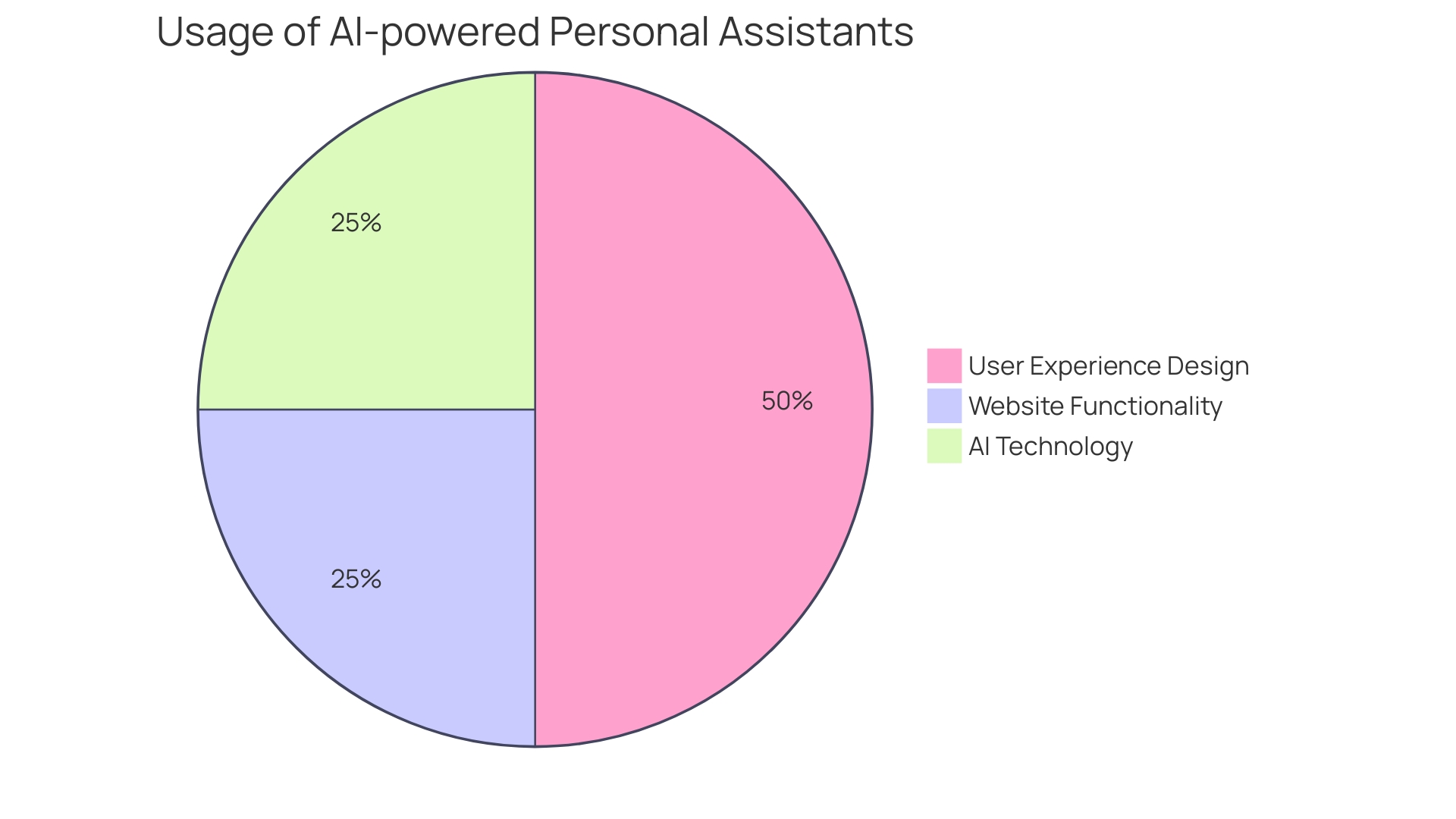
Step 3: Design the Conversation Flow
Crafting the conversational architecture of an AI chatbot is akin to choreographing a dance. It’s about skillfully designing the intricate steps – the give and take of dialogue between individual and bot – that result in a seamless and intuitive interaction. To accomplish this, one must start with broad, open-ended questions to assess the individual’s intention. As the conversation progresses, the bot’s responses become more precise, honing in on the user’s specific needs. This dynamic and continuous refinement of the dialogue is essential for fostering a natural flow of communication.
Recent developments in the field of AI have highlighted the significance of large language models (LLMs) in enhancing conversational AI. By utilizing LLMs, we can guarantee that conversational agents are not only multilingual but also provided with high-quality, immutable data. This approach guarantees that the chatbot’s responses are informed by accurate and relevant information. Moreover, with the integration of AI, organizations are keen to measure the return on investment (ROI) and strategize for the long-term adaptation of AI into their products.
The art of prompt engineering cannot be overstated in this process. It requires a deep understanding of how AI interprets information and the ability to iteratively refine prompts to achieve more sophisticated outputs. As highlighted in a recent session by the founder of ChatbotsLife, the world of conversational AI is rapidly evolving with the advent of LLMs, necessitating an understanding of both their capabilities and limitations to build next-generation AI bots.
In line with Gartner’s predictions, the deployment of chatbots has surged, becoming a key component of customer communication strategies. Their ability to automate conversations and engage with customers in real-time has been instrumental in driving this growth. As we look to the future, the focus is on nurturing this symbiotic relationship between AI and human input, ensuring that both are leveraged to their fullest potential to deliver an unparalleled user experience.

Step 4: Choose the Right AI Chatbot Development Platform or Framework
Choosing the best AI development framework is a crucial choice that can greatly impact the effectiveness and efficiency of deploying your virtual assistant. To make an informed choice, it’s crucial to evaluate platforms based on their usability, feature set, integration options, and scalability potential. Widely recognized platforms in this space include Dialogflow, IBM Watson Assistant, and Microsoft Bot Framework. When assessing these platforms, consider your project’s specific requirements to ensure a perfect fit.
To simplify your decision-making procedure, begin by recognizing the main objective and aims for your conversational AI, including the categories of engagements it will manage. This clarity will help you identify the crucial characteristics and functionalities required for your conversational agent. For example, if your goal is to improve interaction on an e-commerce application across multiple platforms, you’ll need a framework that can seamlessly integrate with both web and mobile environments.
Another essential factor is scalability. As your user base expands, your conversational AI should be able to grow with it. Choose a platform that not only meets your current needs but can also scale to accommodate future demands. This is where evolution qualities, such as maintainability and extensibility, become vital. A scalable platform ensures that as your business grows, your automated messaging system can evolve without requiring a complete overhaul.
Moreover, consider the execution qualities of the platform, like security and usability. These aspects are crucial as they affect the performance of the conversational AI system during operation. With the rise of synthetic data and the need for GDPR and CCPA compliance, selecting a platform that emphasizes data privacy and secure handling of information is imperative.
In today’s competitive environment, where AI is quickly being embraced to enhance productivity and enhance customer interaction, postponing the deployment of an AI-powered conversational agent might lead to overlooked possibilities. Harnessing AI technologies not only simplifies routine tasks but also allows your team to concentrate on strategic initiatives, improving productivity and customer satisfaction.
Finally, integration with existing systems and data sources is essential. A platform that enables effortless connection with your databases and supports multilingual capabilities can offer a more personalized and efficient experience for individuals. Keep in mind, the platform you select will be the foundation of how your conversational AI application engages with users, so it’s crucial to choose one that strongly supports your goals while also being flexible enough to meet future requirements.
Step 5: Training the Chatbot
Enhancing the Ai’s capabilities is a crucial aspect in its development. This process entails equipping the bot with a set of example dialogues to simulate potential interactions. It also requires careful feedback and refinement to improve the conversational capabilities of the AI assistant. For chatbots powered by machine learning, a substantial training dataset is vital to their learning process, whereas rule-based chatbots depend on a comprehensive framework of predefined regulations and patterns. It is crucial to continuously oversee and evaluate the performance of the AI assistant throughout the training phase to verify its progressive learning and efficiency in response. Utilizing the most recent innovations in technology, like blockchain, guarantees the integrity and confidentiality of the training data, enhancing the AI assistant with high-quality input. Furthermore, engaging with the AI assistant using precise prompts can refine its understanding and response accuracy, leading to an improved experience tailored to specific industries or operational needs. By incorporating these tactics, AI chatbots can greatly enhance interaction and function as a powerful tool to mitigate staff shortages and improve patient care, as observed in contemporary healthcare settings such as the NHS.
Step 6: Quality Testing
The convergence of AI development and quality assurance is a dynamic and critical domain, where meticulous testing is not just an option but a necessity. Ensuring that your AI conversational system consistently delivers accurate and relevant answers to a variety of inquiries relies on rigorous testing protocols. The procedure should include two crucial forms of assessments: operational testing, which examines the AI assistant’s ability in performing specific duties, and interaction testing, which gauges the AI assistant’s overall efficiency and user-friendliness for the final individual. By integrating findings from these tests, developers can make informed enhancements, refining the AI assistant to meet and exceed user expectations.
In the context of Enefit, a leading energy provider, the deployment of an AI conversational agent was a transformative strategy to streamline internal information retrieval, which traditionally took employees an average of 18 minutes and sometimes over an hour. Such initiatives underscore the importance of AI in improving operational efficiencies. Furthermore, as seen in healthcare, Ai’s potential extends to clinician support and patient care, emphasizing the need for reliable and unbiased AI solutions. In the broader landscape, Ai’s role is rapidly evolving, with industry experts like Ryan Daws and companies like Microsoft recognizing the value of AI expertise in driving technological advancements.
However, with the growing reliance on large language models (LLMs) comes the increased responsibility to identify when and how these systems may fail. This is echoed by Harmonic’s efforts to develop A.I. technologies that self-validate to prevent misinformation. The practice of prompt testing is becoming increasingly crucial, as highlighted by the shift from traditional test-driven development (TDD) to this new paradigm, ensuring chatbots are meticulously vetted before deployment.
Reflecting on the World Quality Report’s 15-year journey, it’s clear that the landscape of quality engineering and testing has evolved significantly, with a notable shift towards agile methodologies and cloud services. The focus on automation and cost-efficiency in the post-financial crisis period has resulted in the industrialization of software development and QA tasks, paving the way for the advanced AI solutions seen today. These advancements serve as a guiding light for companies navigating the integration of AI into their operations, providing a roadmap for creating high-quality, efficient interfaces.
Step 7: Deployment and Ongoing Maintenance
After careful development and thorough testing, an AI conversational agent transitions into the deployment phase, where it becomes accessible to users. The deployment strategy must be tailored to the audience’s preferences, whether through a website, social media messenger, or mobile application. For example, Enefit, a large Baltic energy company, saw the need to streamline access to internal documents for its 5000 employees. The deployment of an automated messaging system significantly decreased the average duration expended by staff members looking for data from 18 minutes to a few seconds, thus improving operational effectiveness. Monitoring and analyzing interactions with the conversational AI system post-deployment is crucial for continuous improvement. This involves assessing the satisfaction of individuals and the performance of the conversational agent. Consistent upkeep and updates are not discretionary but essential to maintain the conversational AI system in line with changing needs and technological advancements, similar to the ongoing efforts at Benefit to keep their artificial intelligence solutions at the forefront. Incorporating feedback from individuals into this process ensures the virtual assistant remains a valuable resource, consistently providing a positive experience for users.
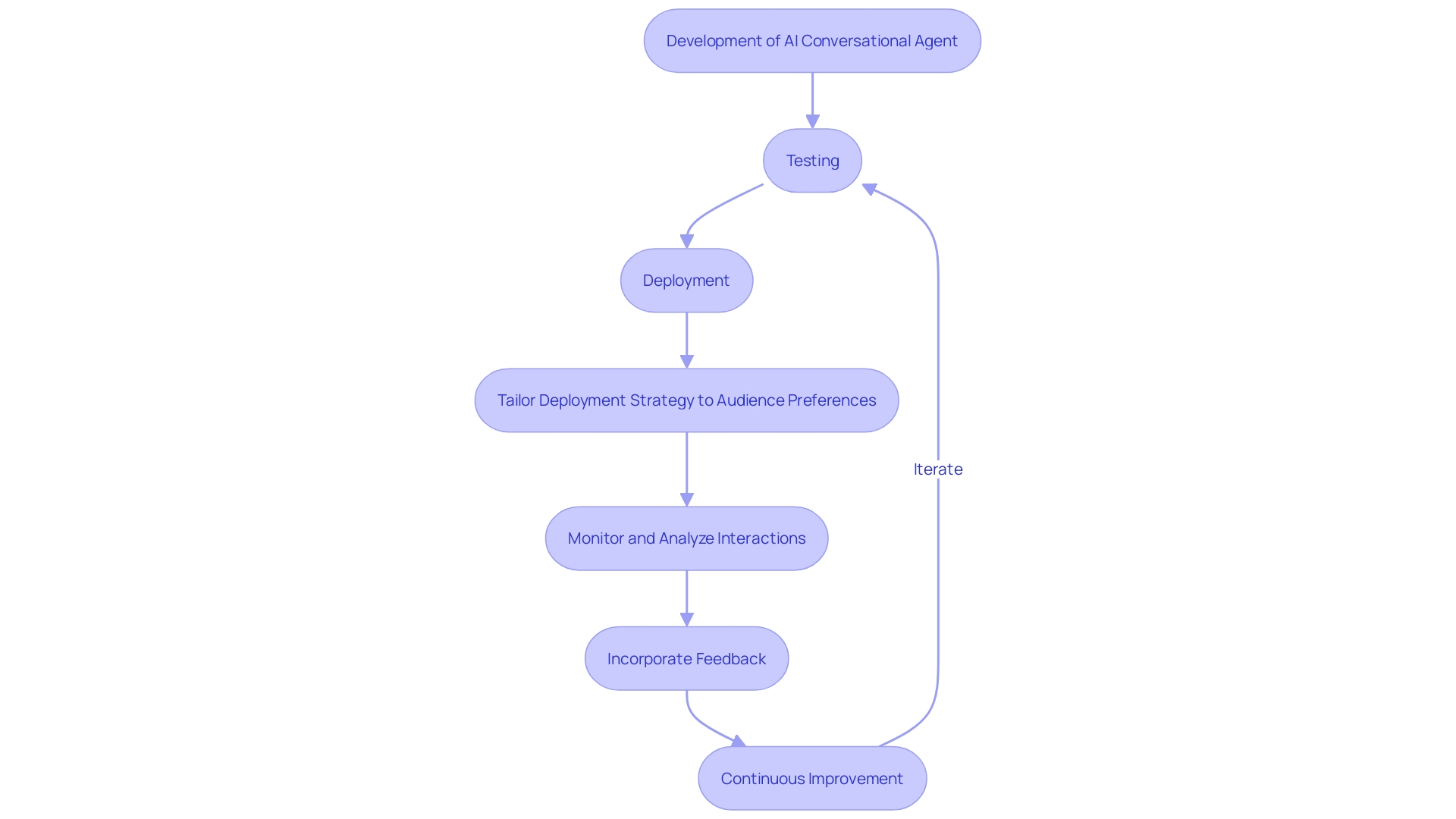
Best Practices for AI Chatbot Development
Developing an AI conversational agent that differentiates itself necessitates not just following established guidelines but also adopting a pioneering strategy for interaction with individuals. By incorporating analytical tools, developers can uncover invaluable insights into individual actions, resulting in a more intuitive and engaging interface. Continuous performance monitoring and iterative improvements are crucial in refining the chatbot’s functionality and ensuring it meets the users’ needs effectively. For example, by implementing the knowledge gained from the Benefit project, an energy company with a large collection of documents, AI virtual assistants can greatly decrease the amount of time employees need to search for company-related information, reducing it from an average of 18 minutes to just a few seconds. Furthermore, the incorporation of technologies like blockchain can offer a pristine, unchangeable data source for virtual assistants, improving their capability to offer precise and multilingual replies. With a strategic approach that combines these elements, developers can deliver AI chatbots that not only enhance user interaction but also contribute to a tangible return on investment.
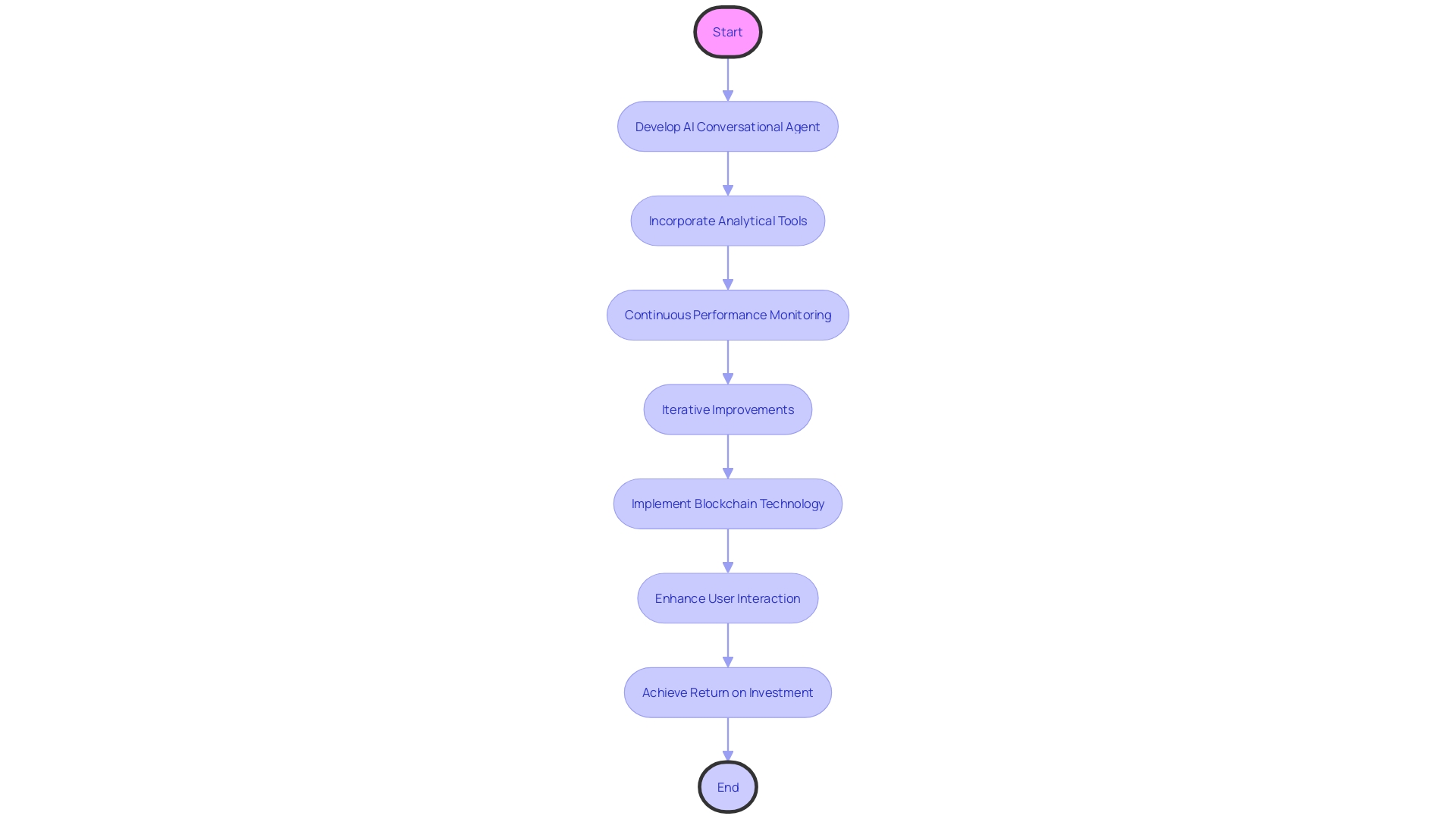
Advanced Techniques in AI Chatbot Development
Advancements in artificial intelligence technology are revolutionizing the way businesses engage with their customers. Sentiment analysis and context-awareness are two cutting-edge techniques that can significantly enhance a chatbot’s capabilities. Sentiment analysis enables automated conversational agents to detect and react to user emotions, fostering a more personalized and empathetic user experience. Context-awareness, conversely, enables AI assistants to preserve information from previous interactions, resulting in a more coherent and efficient conversation flow.
For instance, the Enefit energy company, employing over 5,000 people across five markets, utilized AI technology to streamline access to thousands of internal documents. By reducing the average time needed to find answers from 18 minutes to a matter of seconds, they demonstrated the profound impact of integrating AI into operational processes.
Current market trends reveal a surge in AI adoption, with the AI-powered personal assistants market projected to reach $242.30 billion by 2030. This growth is propelled by Ai’s potential to automate up to 70% of customer requests, and with over 63% of retail companies using AI to enhance customer service, the emphasis on Ai’s role in operational efficiency is clear.
As we delve into neural networks, a core component of AI’s ability to learn and process complex patterns, it’s crucial to understand their structure and application. Neural networks, akin to the human brain, consist of layers of artificial neurons that adapt through backpropagation—a learning mechanism adjusting connection weights from training errors. They excel at tasks such as image and speech recognition, as well as natural language processing, which are crucial for advanced conversational agents.
The integration of AI in customer service not only aligns with strategic product development but also promises significant returns on investment (ROI). As businesses and researchers continue to explore the potential of AI, the focus on specialized agents and domain-specific applications is leading to more effective, privacy-conscious, and user-centric AI solutions.
Common Challenges and Solutions in AI Chatbot Development
Strategically implementing AI chatbots requires a deep understanding of the challenges and opportunities they present. For example, uncertainty in input from individuals, complicated dialogues, and the requirement for strong privacy and security measures are common obstacles. Addressing these necessitates a fusion of sophisticated methods like intention identification, which aids in distinguishing intentions, and slot completion, which captures crucial information during interactions. Moreover, dialogue management strategies can help in orchestrating the conversation flow effectively.
From real-world applications, such as Enefit’s AI system aimed at streamlining employee access to internal documents, we learn that the average time to find company-related answers was significantly reduced. Such examples underscore the importance of AI in operational efficiency. Also, insights from the NHS’s adoption of digital technologies illustrate the necessity for a thorough assessment of AI tools to ensure they meet security and compliance standards.
The potential of AI is further emphasized by the integration of Large Language Models (LLMs) and blockchain technology, ensuring clean, confidential data that can be multilingual. Companies like Exfluency are at the forefront, offering hybrid intelligence solutions that valorize linguistic assets.
When considering AI integration, it’s crucial to inquire how it will generate ROI, fit into the long-term product strategy, and what maintenance processes are necessary. Additionally, the AI should be aligned with addressing important problems for users and enhancing the customer journey. An AI solution should only be pursued if it is the most effective option available.
Supporting this with statistics, AI has automated up to 70% of customer requests, with over 63% of retail companies using AI to enhance customer service. Furthermore, the rise in generative AI applications in customer service strategies is a testament to the technology’s value, considering the high abandonment rates due to poor service experiences. Lastly, chatbots serve as an initial step in lead qualification, with research showing their widespread use on websites for contact collection and user support.
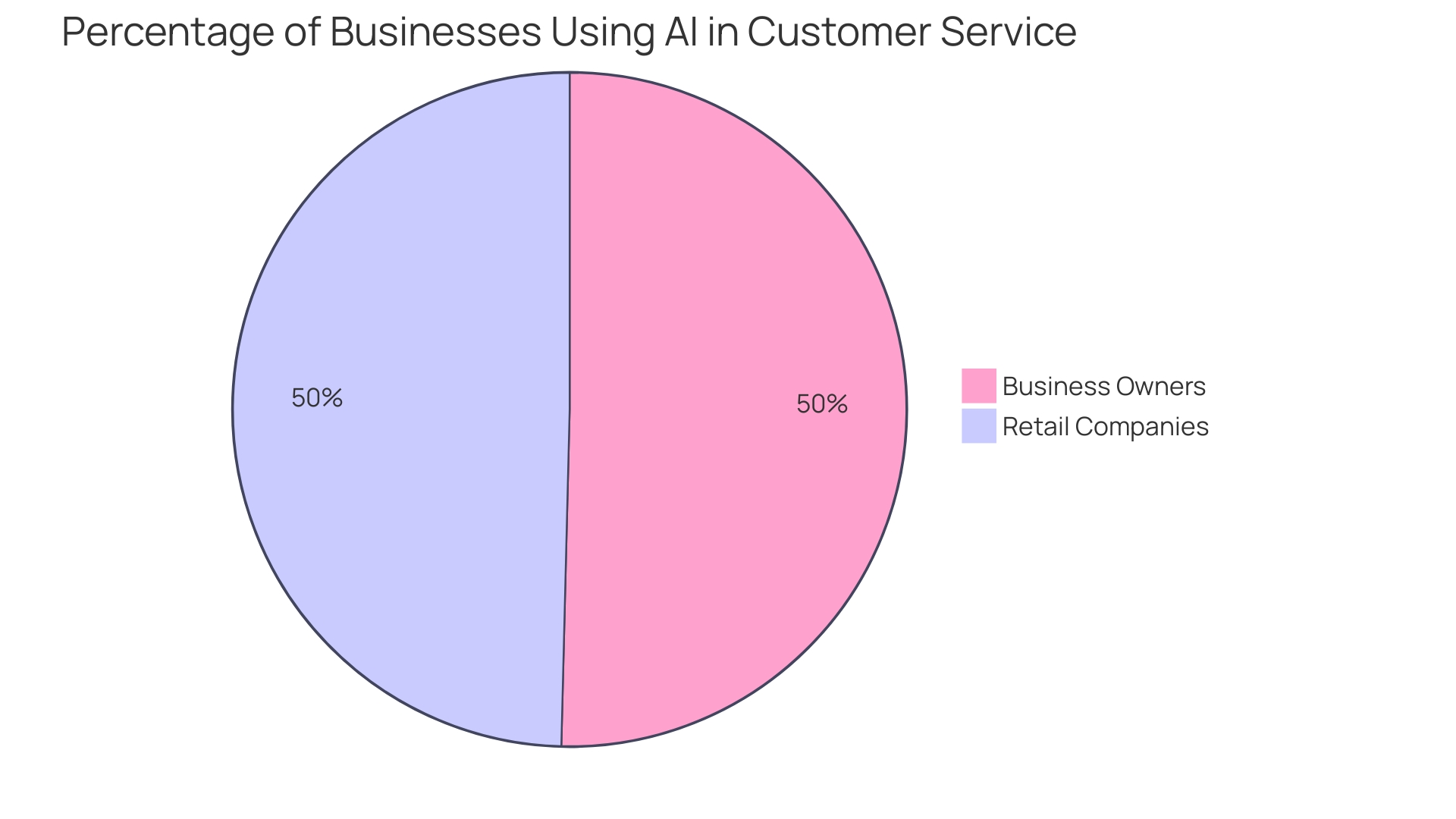
Conclusion
In conclusion, AI chatbots have become essential tools for enhancing user interaction in various industries. Understanding the different types of chatbots, such as rule-based systems and machine learning-driven ones, is crucial for planning a chatbot strategy.
Implementing AI chatbots can lead to impressive returns on investment, automating up to 70% of customer requests and improving operational efficiency. They can act as sophisticated assistants, driving long-term product strategies and operational goals.
By following best practices and leveraging advanced techniques like sentiment analysis and context-awareness, businesses can create AI chatbots that enhance user interaction and provide a personalized experience.
Overcoming common challenges in AI chatbot development, such as ambiguity in user input and privacy concerns, can be achieved through intent recognition, slot filling, and effective dialogue management strategies.
Choosing the right development platform and conducting quality testing are crucial for successful deployment and ongoing maintenance of AI chatbots. Continuous monitoring and refinement ensure alignment with evolving user needs and technological advancements.
In summary, AI chatbots offer practical solutions to enhance user interaction and improve operational efficiency. By harnessing the power of AI, businesses can create chatbots that deliver a positive user experience and drive meaningful results.

